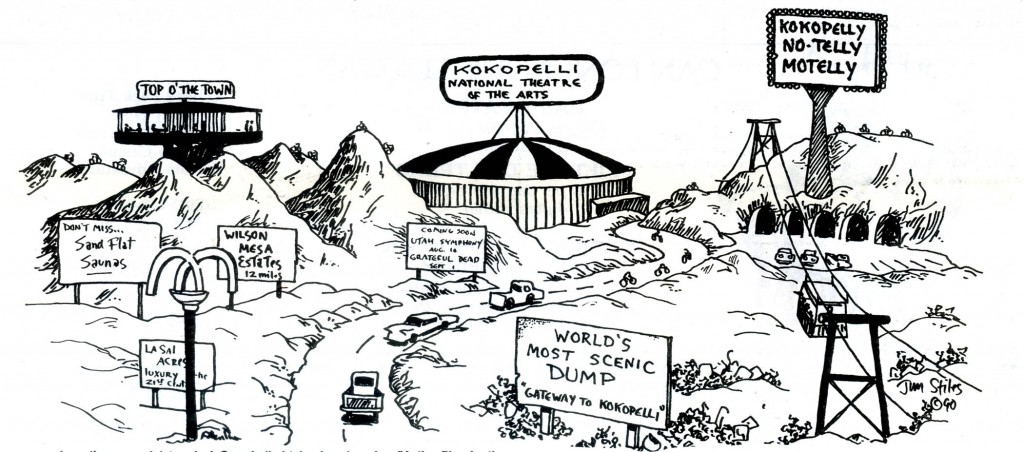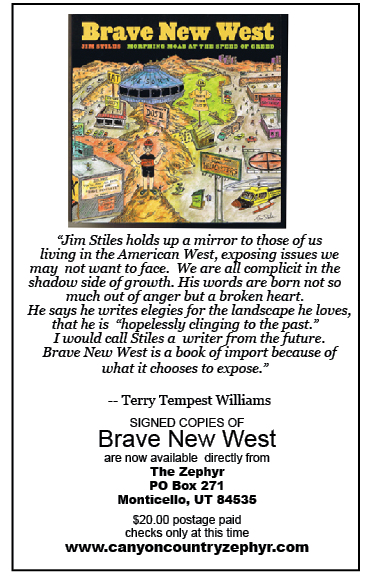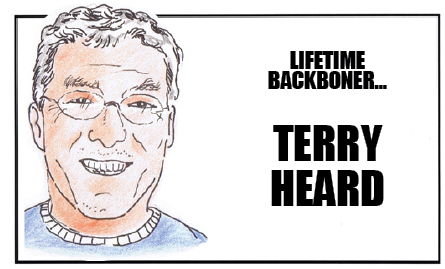What Might Have Been?
In 1990, Moab was in the process of being “re-discovered” yet again. The University of Utah announced plans to build a massive Kokopelli National Theater on the Sand Flats adjacent to the Slick Rock Bike Trail. The plan was met with mixed reviews. This publication thought the idea was insane. We covered the progress of the Kokopelli Theater from its beginnings to its quiet demise. Here, from August 1990, was our first story on the Kokopelli Theater…JS
Recently the University of Utah, in conjunction with the Bureau of Land Management, announced plans to construct a $9.5 million theatre complex on the Sand Flats Road adjacent to the Slick Rock Bike Trail. The multi-phase project includes an outdoor amphitheater, an outdoor theatre in the round, a theatre of the stars for astronomical programs and an enclosed year-round performing arts center. The price tag would be paid for by $6 million in federal funding and the remainder from non-federal matching funds.
The news of the planned facility came as something of a surprise to most Moab residents, who knew little if anything about the theatre complex. In a February 1, 1990 story in the Moab Times-Independent, “the possibility of construction of a large natural amphitheater” was mentioned but nothing was described that came close to the scope of the project as it emerged five months later. In February, the BLM prepared an Environmental Assessment for a land withdrawal under the Recreation and Public Purpose Act (R&PP,) which allows the Bureau to reclassify public lands so that a government entity can apply to utilize that land “for the public purpose.” In this case, the BLM withdrew 368 acres adjacent to the Slickrock Bike Trailhead. Area manager Brad Palmer signed the EA in April and after public notices were run in the T-I, the R&PP withdrawal went into effect 60 days later.
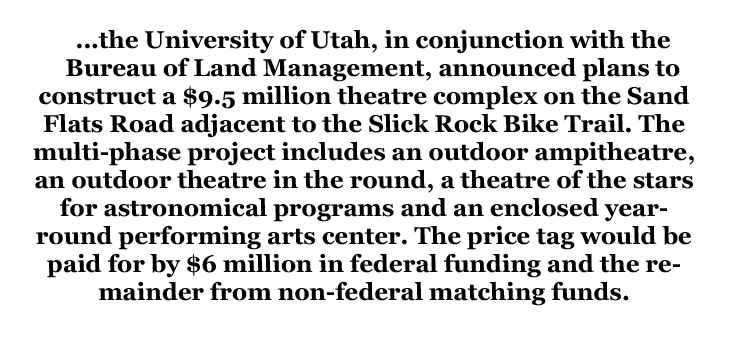
A veil of secrecy fell over the project in the late Spring and early Summer. Jack Campbell, a contributing writer to the Zephyr who has closely followed the theatre’s progress, expressed concern that the public was being left out of the decision-making process. When I attempted to collect information and clarify some of the rumors that were circulating, I was met by a stone wall. The BLM claimed it could not discuss certain aspects of the proposal, and in an impromptu conversation with Geoffrey Panos of the U of U, he could only say, “We will tell you when we are ready.” I was not even sure who “we” were, and Mr. Panos refused to enlighten me. But he did assure me that the scope of the project was in its earliest stages—the talk stage—and that there would be plenty of time for public participation.
Less than a week later, Jack Campbell obtained copies of an “Action Plan for the Kokopelli National Theater Proposal—May ‘90” and a draft proposal for the theatre. The action plan broke the development of the theater into phases, complete with costs and estimated completion dates. The draft proposal described the five phases in some detail. Included in the package:
Kokopelli National Theater & Recreational Area
Five-Phase Development
1. Performances
Theatre in-the-round
Theatre of the Sky
Concert Shell
2. Water & restroom chambers
Nature walks
Arboretum development
Reflecting pool and area beautification
Certain areas segregated and protected ( i.e. from mountain bikes and 4-wheel drives.)
3. Theatre storage chamber & power
handrails & handicap accessibility
Parking lot/dump reclamation
Audience/biker shuttle
4. Campgrounds/restrooms
Bike-trail BLM Ranger station
Shaded facility
Current bike-trail parking lot/rest room beautification
5. Year-round enclosed stage
Prop-costume/rehearsal chambers
U of U/BLM educational chambers
Apparently the process had indeed gone beyond the talk stage. In fact, the Action Plan’s May 1990 date was a full month before my conversation with Mr. Panos. Two weeks late, Senator Jake Garn and Representative Wayne Owens introduced legislation to set aside $6 million for the establishment of a Kokopelli National Theatre of the Arts. It appeared that the proposal was developing a head of steam before anyone knew of its existence.
Of concern to the University and to the BLM was the existence of nine parcels of state land in the Sand Flats area. In order to proceed with the theatre plan, both the U of U and the BLM felt that these parcels of land should be dealt with in a way that would not lead to overdevelopment and exploitation of the area. The BLM initiated the paperwork that might eventually lead to the transfer of those state sections to the Bureau, in exchange for property elsewhere. And Governor Bangerter authorized the State Land Board to proceed in good faith to complete the transfer of those lands.
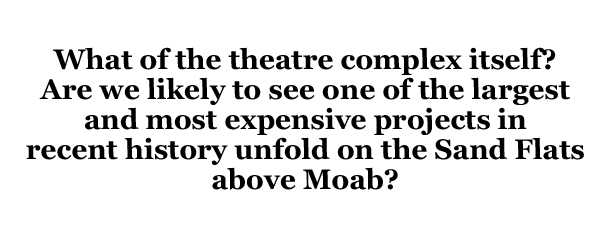
But there is a built-in Catch-22 to the attempted land exchange as acknowledged by Doug Fullmer of the Moab State Lands Office. They are mandated with the responsibility of producing maximum revenues from those lands for the State School Trust. If the theatre complex appears to be a viable plan, what does it do to the value of the State sections? Obviously, it makes the value go up substantially, and gives the State Land Office a great deal of leverage in bargaining for other lands. As Mr. Fullmer said, “The BLM had better be very cooperative.” What if the BLM fails to counter-offer with property equal in value? According to Fullmer, the deal could fall through. Presently those lands have been withdrawn for 18 months, but so far there is no assurance that their transfer will take place.
What of the theatre complex itself? Are we likely to see one of the largest and most expensive projects in recent history unfold on the Sand Flats above Moab? Last week I spoke to Scott Kearin, an aide to Congressman Wayne Owens, who has worked closely with the University’s plans. Scott Kearin:
“First of all, the reality is that neither of the bills that were introduced is going to pass this year. This is a way to open up the dialogue. In retrospect, we probably should have cut out the $6 million and put in $2 million. In reality, it doesn’t mean very much. There may be a difference of opinion (with Senator Garn.) You’ll find that one camp prefers a very large, expensive facility and there will be a majority, I think, who prefer something smaller and more appropriate.
“When we got wind that the University was planning to lease some land from the BLM for outdoor performances, we thought, that’s not a bad idea–’a la Wolftrap except not so developed. It’s more developed than we would ever be.
“The position we take is this: That area on top near the hogback would be available for outdoor performances, but with little development. There’s a natural amphitheatre that would also serve well as a backdrop for certain performances. We’ll have those two thing and then some sort of semi-permanent, very limited stage. But not a 3000 seat indoor arena. We consider that inappropriate and we’ve been firm on that all along.
“Environmentally, the project would be benign. Our concern is to make sure we don’t start envisioning some inappropriate facilities which aren’t well-placed—we want it to be an outdoor theatre…we expect that a public process will turn out an idea that is a lot more minimalist in concept. We think it’s a great idea in that we thought it was a nice division of interior land for performances. But we don’t want to create a monster. We can’t have overkill, and as much as we can, we’ll be a watchdog.”
Obviously, Congressman Owens’ vision of the Kokopelli National Theatre was considerably different and more modest than the concept envisioned by Geoff Panos. In an effort to explain the University’s position, Panos invited members of the Board of the Moab Fine Arts Center to an on-site inspection of the proposed development. On the morning of July 21, Jack Campbell and I accompanied the group to the Sand Flats.
It became readily apparent from the number of questions raised and the paucity of answers provided that this project has miles to go before it can be considered viable. Although Panos discussed the notion that the performing arts theatre must be self-sustaining, no studies have been made to determine revenues needed to accomplish that goal. Estimates on the size of the enclosed stage have ranged from 300 to 1000. No one really knows. Board member Karla Van der Zanden observed that, “The University, in order to consider being involved from a business point of view, would require a feasibility study or a business plan.”
Panos observed, “The whole point of this thing is to have an experience that you can’t have anywhere else on earth; people aren’t going to fly in from all over the world to sit inside a theatre. We want them to find the magic and reverence and absorb this experience.”
Gibbs Smith replied that the challenge is to accommodate large numbers of people without degrading the environment they have come to admire. Yet, any large indoor theatre would almost certainly have a serious environmental/visual impact on the area. Construction damage alone could be staggering.
Jack Campbell commented that, “the fear among many of us is that we might buy into a project that becomes economically driven rather than a project where the criteria are set up by the environment and a number of other values. It’s a little scary to jump into something where what happens is determined by economic needs.”
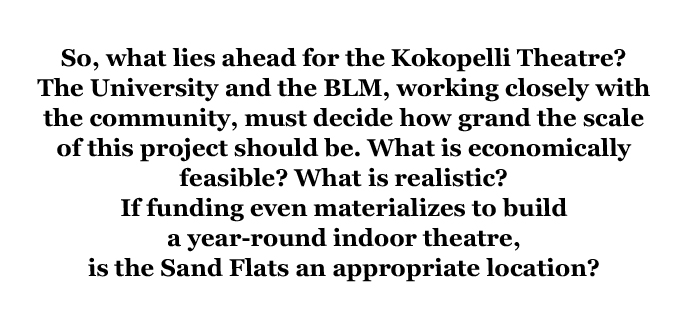
Of great concern to the group was the State land issue. One parcel, directly adjacent to the theatre area, has been leased by Micheal Hill of Moab. The 39-year lease has been approved and Mr. Hill has discussed the possibility of building a 40 unit motel by drilling large caverns in the slickrock. Development of the nine other parcels could forever alter the nature of the Sand Flats area and the trigger to set off such development is the theatre complex itself. That is why it was so important that the transfer of those State lands be completed as quickly as possible. Later, at a meeting of the Board, a resolution was passed which said, in effect, the exchange of those nine parcels of State land must be accomplished as a pre-condition for continued development of the Kokopelli Theatre project.
So, what lies ahead for the Kokopelli Theatre? The public will have its first opportunity to express its opinion at a BLM scoping hearing on August 2. The University and the BLM, working closely with the community, must decide how grand the scale of this project should be. What is economically feasible? What is realistic? If funding even materializes to build a year-round indoor theatre, is the Sand Flats an appropriate location? Would it be more effective to construct such a theatre nearer to downtown Moab where local businesses could more greatly benefit? What would the cost be to the city and county to maintain and improve roads to the theatre, as well as other services that may be required (police, fire, utilities)?
Only through a planned and prudent process can we find the answers to these and other questions, and truly do what is best for the community, the University, and the people who visit our canyon country.
POSTSCRIPT: Eventually, the idea faded away as federal monies to finance the massive project became scarce. But what would happen today?
MORE ON THE STORY FROM THE WEB…
http://www.deseretnews.com/
http://savemillcreek.files.wordpress.com/2012/06/slickrock-planning-comittee-recomend004.pdf
To read the PDF version of this article, click here.
Don’t forget the Zephyr ads! All links are hot!

